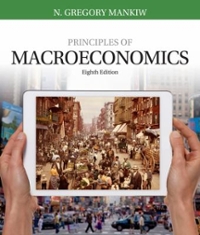Question
PLEASE ANSWER ALL WITH EXPLAINATION 1) Vincent is deciding whether to buy a painting. The current sale price of the painting is 100 dollars. The
PLEASE ANSWER ALL WITH EXPLAINATION 1) Vincent is deciding whether to buy a painting. The current sale price of the painting is 100 dollars. The resale price of the painting after T years is 100 + T dollars, where T is a positive integer. Ownership of the painting generates a psychological benefit of 10 dollars per year, where the benefit is received at the end of each year. Assume that the discount rate is r = 0.10. (a) Suppose that Vincent buys the painting. What is the earliest year after which he should sell the painting? [Hint: maximize the net present value with respect to the year after which he sells the painting.] (b) Suppose that Vincent sells the painting as in part (a). What is the net present value for his investment decision? (c) Should Vincent buy the painting? Explain briefly. (d) Suppose instead that Vincent cannot sell the painting after purchase. What is the internal rate of return on the investment in the painting? 2) Mason has the utility function U(C, R) = C R, where C is consumption, and R is leisure. The price of a unit of consumption is one. There are 24 hours available that can be divided between working and leisure. Let w = 1 be the wage received per hour of work. Mason has an unearned income of Y = 4. (a) What is Mason's budget constraint? [Hint: consumption should equal labor income plus unearned income.] (b) What is the quantity of labor supplied by Mason? (c) Suppose that the government imposes a 50% tax only on labor income. What is the quantity of labor supplied by Mason? (d) Suppose that the government imposes a 50% tax only on unearned income. What is the quantity of labor supplied by Mason? 3) Norma has the utility function u(c1, c2) = log(c1) + log(c2), where c1 is consumption in period 1, and c2 is consumption in period 2. Norma receives an income of I = 36 in each of the two periods. She can borrow and save at an interest rate of r. The price of a unit of consumption is one in each period. (a) What is Norma's intertemporal budget constraint? [Hint: the present discounted value of consumption should equal the present discounted value of earnings.] (b) Suppose that r = 0 and = 1. What is Norma's consumption in each period? (c) Suppose that r = 0.5 and = 1. What is Norma's consumption in each period? (d) Suppose that r = 0.5 and = 0.25. What is Norma's consumption in each period? 4) Consider a competitive labor market with 800 identical firms. Each firm has the production function f(l) = l, where l denotes the amount of labor employed by the firm. The price of a unit of output is fixed at P = 1. Let w be the wage rate. The market supply of labor is given by L = 1600w. (a) What is the market demand for labor as a function of the wage rate? [Hint: the labor demand of an individual firm is derived from profit maximization.] (b) What is the equilibrium wage rate? (c) What is the elasticity of the market demand for labor with respect to the wage rate? (d) What is the economic rent earned by labor?
Step by Step Solution
There are 3 Steps involved in it
Step: 1

Get Instant Access to Expert-Tailored Solutions
See step-by-step solutions with expert insights and AI powered tools for academic success
Step: 2

Step: 3

Ace Your Homework with AI
Get the answers you need in no time with our AI-driven, step-by-step assistance
Get Started


